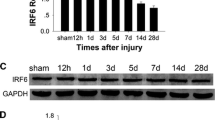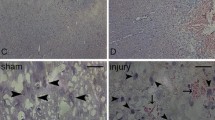Abstract
The protein TFIIB is a general transcription initiation factor that plays a pivotal role in the preinitiation complex (PIC) and selects the transcription initiation site. However, its distribution and function in the central nervous system (CNS) remains unclear. In the present study, we mainly investigated the expression and cellular localization of TFIIB during traumatic brain injury (TBI). Western blot analysis revealed that TFIIB was present in normal rat brain cortex. It gradually increased, reached a peak at the 5th day after TBI, and then decreased. Importantly, more TFIIB was colocalized with astrocytes and microglia, which are largely proliferated. In addition, Western blot detection showed that the 5th day post injury was also the proliferation peak indicated by the elevated expression of PCNA. Importantly, injury-induced expression of TFIIB was colabelled by proliferating cell nuclear antigen (proliferating cells marker). These data suggested that TFIIB may be implicated in the proliferation of astrocytes and microglia and the recovery of neurological outcomes. But the inherent mechanisms remained unknown. Further studies are needed to confirm the exact role of TFIIB after brain injury.




Similar content being viewed by others
References
Buratowski S, Zhou H (1993) Functional domains of transcription factor TFIIB. Proc Natl Acad Sci USA 90:5633–5637
Chen XH, Iwata A, Nonaka M et al (2003) Neurogenesis and glial proliferation persist for at least one year in the subventricular zone following brain trauma in rats. J Neurotrauma 20:623–631
Chen J, Wu X, Shao B et al (2011) Increased expression of TNF receptor-associated factor 6 after rat traumatic brain injury. Cell Mol Neurobiol 2:269–275
Chirumamilla S, Sun D, Bullock MR et al (2002) Traumatic brain injury induced cell proliferation in the adult mammalian central nervous system. J Neurotrauma 19:693–703
Clark RS, Kochanek PM, Chen M et al (1999) Increases in Bcl-2 and cleavage of caspase-1 and caspase-3 in human brain after head injury. FASEB J 13:813–821
Davidson I (2003) The genetics of TBP and TBP-related factors. Trends Biochem Sci 28:391–398
Felzien LK, Farrell S, Betts JC et al (1999) Specificity of cyclin E-Cdk2, TFIIB, and E1A interactions with a common domain of the p300 coactivator. Mol Cell Biol 19:4241–4246
Friedman MJ, Shah AG, Fang ZH et al (2007) Polyglutamine domain modulates the TBP-TFIIB interaction: implications for its normal function and neurodegeneration. Nat Neurosci 10:1519–1528
Ha I, Lane WS, Reinberg D (1991) Cloning of a human gene encoding the general transcription initiation factor IIB. Nature 352:689–695
Ha I, Roberts S, Maldonado E et al (1993) Multiple functional domains of human transcription factor IIB: distinct interactions with two general transcription factors and RNA polymerase II. Genes Dev 7:1021–1032
Hampsey M (1998) Molecular genetics of the RNA polymerase II general transcriptional machinery. Microbiol Mol Biol Rev 62:465–503
Hisatake K, Malik S, Roeder RG et al (1991) Conserved structural motifs between Xenopus and human TFIIB. Nucleic Acids Res 19:6639
Hochheimer A, Zhou S, Zheng S et al (2002) TRF2 associates with DREF and directs promoter-selective gene expression in Drosophila. Nature 420:439–445
Jia J, Yan M, Lu Z et al (2010) Regulated expression of pancreatic triglyceride lipase after rat traumatic brain injury. Mol Cell Biochem 335:127–136
Keane RW, Kraydieh S, Lotocki G et al (2001) Apoptotic and antiapoptotic mechanisms after traumatic brain injury. J Cereb Blood Flow Metab 21:1189–1198
LaPlaca MC, Simon CM, Prado GR et al (2007) CNS injury biomechanics and experimental models. Prog Brain Res 161:13–26
Logan A, Frautschy SA, Gonzalez AM (1992) A time course for the focal elevation of synthesis of basic fibroblast growth factor and one of its high-affinity receptors (flg) following a localized cortical brain injury. J Neurosci 12:3828–3837
Malik S, Hisatake K, Sumimoto H et al (1991) Sequence of general transcription factor TFIIB and relationships to other initiation factors. Proc Natl Acad Sci USA 88:9553–9557
Moore PA, Ozer J, Salunek M, Jan G et al (1999) A human TATA binding protein-related protein with altered DNA binding specificity inhibits transcription from multiple promoters and activators. Mol Cell Biol 19:7610–7620
Morganti-Kossmann MC, Rancan M, Stahel PF et al (2002) Inflammatory response in acute traumatic brain injury: a double-edged sword. Curr Opin Crit Care 8:101–105
Morris GF, Mathews MB (1989) Regulation of proliferating cell nuclear antigen during the cell cycle. J Biol Chem 264:13856–13864
Mrak RE, Griffin WS (2005) Glia and their cytokines in progression of neurodegeneration. Neurobiol Aging 26:349–354
Myer VE, Young RA (1998) RNA polymerase II holoenzymes and subcomplexes. J Biol Chem 273:27757–27760
Nortje J, Menon DK (2004) Traumatic brain injury: physiology, mechanisms, and outcome. Curr Opin Neurol 17:711–718
Ohbayashi T, Makino Y, Tamura TA et al (1999) Identification of a mouse TBP-like protein (TLP) distantly related to the drosophila TBP-related factor. Nucleic Acids Res 27:750–755
Orphanides G, Lagrange T, Reinberg D (1996) The general transcription factors of RNA polymerase II. Genes Dev 10:2657–2683
Pinto I, Ware DE, Hampsey M (1992) The yeast SUA7 gene encodes a homolog of human transcription factor TFIIB and is required for normal start site selection in vivo. Cell 68:977–988
Rabenstein MD, Zhou S, Lis JT et al (1999) TATA box-binding protein (TBP)-related factor 2 (TRF2), a third member of the TBP family. Proc Natl Acad Sci USA 96:4791–4796
Shi W, Zhao W, Shen A et al (2011) Traumatic brain injury induces an up-regulation of Hs1-associated protein X-1 (Hax-1) in rat brain cortex. Neurochem Res 3:375–382
Sofroniew MV (2005) Reactive astrocytes in neural repair and protection. Neuroscientist 11:400–407
Somera-Molina KC, Robin B, Somera CA et al (2007) Glial activation links early-life seizures and long-term neurologic dysfunction: evidence using a small molecule inhibitor of proinflammatory cytokine upregulation. Epilepsia 48:1785–1800
Tatsumi K, Haga S, Matsuyoshi H et al (2005) Characterization of cells with proliferative activity after a brain injury. Neurochem Int 46:381–389
Tehranian R, Rose ME, Vagni V et al (2008) Disruption of Bax protein prevents neuronal cell death but produces cognitive impairment in mice following traumatic brain injury. J Neurotrauma 25:755–767
Tsuboi A, Conger K, Garrett KP et al (1992) RNA polymerase II initiation factor alpha from rat liver is almost identical to human TFIIB. Nucleic Acids Res 20:3250
Wampler SL, Kadonaga JT (1992) Functional analysis of Drosophila transcription factor IIB. Genes Dev 6:1542–1552
Wieczorek E, Brand M, Jacq X et al (1998) Function of TAF(II)-containing complex without TBP in transcription by RNA polymerase II. Nature 393:187–191
Yamashita S, Wada K, Horikoshi M et al (1992) Isolation and characterization of a cDNA encoding Drosophila transcription factor TFIIB. Proc Natl Acad Sci USA 89:2839–2843
Acknowledgments
This work was supported by the National Natural Science Foundation of China (No. 30770488, No. 30870320, No. 31070723 and No. 81070275); Natural Science Foundation of Jiangsu province (No. BK2009156, No. BK2009157, No. BK2009161 and No. BK2010169); A Project Funded by the Priority Academic Program Development of Jiangsu Higher Education Institutions (PAPD).
Author information
Authors and Affiliations
Corresponding authors
Additional information
Zhiqiang Liu and Donglin Wang contributed equally to this work.
Rights and permissions
About this article
Cite this article
Liu, Z., Wang, D., Shao, B. et al. Increased expression of transcription initiation factor IIB after rat traumatic brain injury. J Mol Hist 42, 265–271 (2011). https://doi.org/10.1007/s10735-011-9330-x
Received:
Accepted:
Published:
Issue Date:
DOI: https://doi.org/10.1007/s10735-011-9330-x




